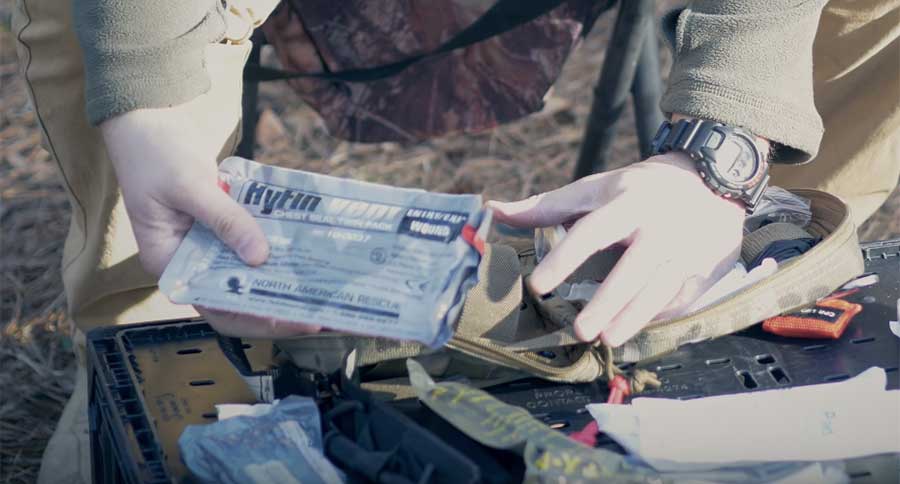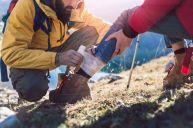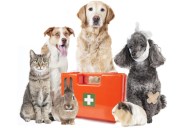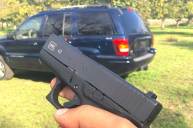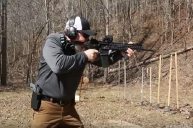If you think you might get into a gun fight, we strongly recommend having something to plug the hole.
You can read many articles on the responsibilities of concealed carry; among other things, mandatory courses and registration are requirements in many states before you can strap on a pistol. What sometimes gets overlooked is the medical aspect. If you or someone you're trying to protect is injured by an assailant's weapon, it sure is nice to be able to respond before the paramedics get to you.
The following supplies are literally life-savers.
For Blood Loss:
- Quikclot Combat Sponge ($14.86): Helps blood clot three times faster than it would naturally
- Self-Adhesive Gauze Dressing (six rolls for $9.89): Wrap the wound and aid in compression
- Tourniquet ($16.97): One of the first things any rescue professional will tell you is that you are much more likely to need a tourniquet than a gun. Carry one.
- EMT shears ($10.90): Very important for safely cutting clothing and other barriers out of the way of the wound.
- Chest Seal (two count for $17.25): For wounds that a tourniquet can't help, these are safe to use on a non-sterile area and can help prevent some of the trauma of a punctured lung.
For Personal Safety:
- Nitrile Exam Gloves (50 pairs for $9.04):
- CPR Shield/Barrier or Mask ($4.95): if you have ever received training in CPR, put one of these on your keychain; you never know when you might need to step in as a Good Samaritan.
Total cost: Your grand total, if you started without a single one of these, would be $83.86. This is a small price to pay for a small but crucial amount of life-saving medical preparedness. Keep these in your car and you may thank yourself later (but pray you never have to).
Another very good option is to carry a pre-made gunshot wound and first aid emergency kit, such as the Doom and Gloom portable med kit reviewed below by Black Scout Survival. These are usually more expensive than what we outlined above, but they come with more supplies and can be well worth it for those who don't feel confident assembling their own kits.
There you have it, a highly portable emergency med kit that will allow you to at least stabilize major wounds until EMS can get on site. That being said, to be effective with a med kit in an emergency situation you need to have some form of training.
Military front line warriors take courses such as Tactical Combat Casualty Care to give them the basics to treat such things as gunshot wounds. These courses typically run at least a week if not ten days and bring a guy to a standard to treat wounds until a casualty can be handed off to professional medical resources.
For you to be effective in an emergency you need training, so shop around, there are some great courses out there. Some are tailored to wilderness survival with detailed lessons on how to treat gun shot wounds. There are also courses taught by medical experts and former military medical specialists that will give you the basics to keep someone alive. The whole point is to avoid major medical invasive techniques that require serious medical skills yet still have the ability to apply pressure to a wound, reduce bleeding with bandages and other methods, and keep a casualty out of shock until the experts get on site.
The final aspect is the portability of med kits. Even though they can be quite small, it is sometimes unrealistic to carry on you at the office or in an urban area. Just ensure you have the kit somewhere nearby, like in your vehicle or at your desk.
When in the wilderness you should have it with you at all times, in your backpack or on your belt. You can treat a myriad of injuries so a good kit is multi-purpose and not just for those serious gunshot wounds.
When you make the decision to carry, you will invariably train hard to be effective with your guns, but you should also consider having a med kit nearby with the appropriate level of training for an emergency situation.
Until the next installment, train hard and train right!
NEXT: THE ARMED CITIZEN SERIES: DO YOU KNOW THESE 2 ESSENTIAL CONCEALED CARRY TECHNIQUES?
